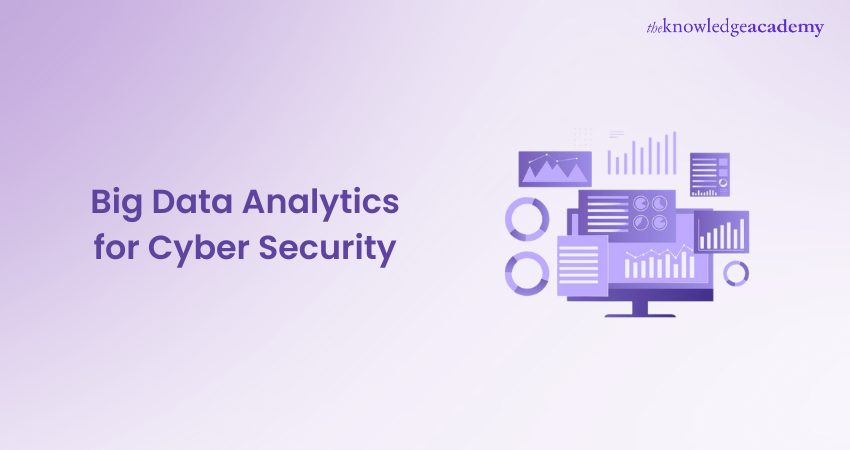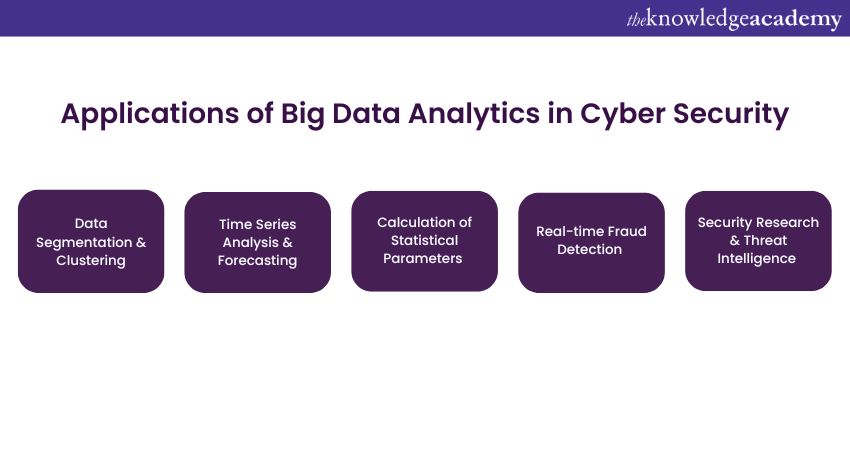We may not have the course you’re looking for. If you enquire or give us a call on +32 35001305 and speak to our training experts, we may still be able to help with your training requirements.
Training Outcomes Within Your Budget!
We ensure quality, budget-alignment, and timely delivery by our expert instructors.

Think of the world of Cyber Security as a vast ocean, teeming with threats and opportunities alike. Just like an adept sailor navigates through turbulent waters, experts in Cyber Security need advanced tools to steer clear of potential dangers. This is where Big Data Analytics for Cyber Security comes into play, offering a sophisticated approach to identifying and mitigating cyber threats before they cause harm.
According to Statista, the average cost of a data breach in the United Kingdom was approximately £3.27 million, underscoring the urgent need for advanced Cyber Security tools. Imagine having a powerful radar that not only detects incoming storms but also predicts future weather patterns. Big Data Analytics for Cyber Security acts in a similar fashion, sifting through massive volumes of data to uncover hidden patterns and anomalies that could signal a potential cyber-attack.
By leveraging these insights, organisations can proactively safeguard their digital assets, ensuring a secure and resilient cyber environment. So, if you are interested in learning more about Big Data Analytics for Cyber Security, then this blog is for you.
Table of Contents
1) What is Big Data Analytics for Cyber Security?
2) How is Big Data being used to Analyse Potential Threats?
3) How is Big Data Changing the Cyber Security sector?
4) Top 5 Applications of Big Data Analytics in Cyber Security
5) Conclusion
What is Big Data Analytics for Cyber Security?
Big Data Analytics for Cyber Security is a cutting-edge approach combining advanced analytical methods with Cyber Security expertise. It helps prevent, detect and respond to potential breaches more effectively than traditional methods. This helps safeguard digital assets and sensitive information by leveraging Machine Learning, Artificial Intelligence, and supervised learning methods.
Here are the prominent types of Big Data Analytics for Cyber Security:

a) Predictive Analysis: Utilises Big Data and AI to forecast security breaches by identifying potential threats before they occur. This allows organisations to proactively strengthen their defences.
b) Prescriptive Analysis: A real-time tool that recommends prompt actions to prevent cyber threats. This enables swift and informed decision-making to counteract potential vulnerabilities.
c) Cyber Analytics: Identifies real-time threats by analysing patterns in vast datasets, providing insights into suspicious activities and emerging trends that may signify imminent cyber-attacks.
d) Diagnostic Analytics: Investigates root causes of security incidents through Big Data Analysis, increasing the understanding of how and why breaches occur.

How is Big Data Being Used to Analyse Potential Threats?
In today's era, collecting vast amounts of data is much easier. But what is important is to understand how such data can be used to improve Cyber Security practices.
Companies can conduct an in-depth analysis to develop data 'norms' initially. Combined with future research, these norms enable a corporation to quickly discover differences between the two to detect breaches and attacks.
The next stage is automating the process as feasible so that the appropriate people can identify and address deviations as soon as possible. This can be accomplished by reducing complicated data structures to more accessible forms. This technique becomes more successful over time as long-term trends detect deviations that would not have been seen in a one-time check.
The rapid increase in Big Data is enabled by Machine Learning (ML) and Deep Learning (DL), the two subsets of Artificial Intelligence. Large volumes of data can be processed using DL and ML techniques to detect patterns. These patterns allow firms to identify possible Cyber Security risks.
The most difficult challenge for Cyber Security teams is the ability to analyse data in a timely way, extracting valuable insights and spotting risks quickly to allow an incident response.
How is Big Data Changing the Cyber Security Sector?
Before Big Data, the Cyber Security world looked very different. As hackers’ attack tactics have become more sophisticated, Big Data has become a vital tool in fighting emerging threats for corporations.
Before the use of Big Data, there were two methods to detect Cyber Security threats:
Risk Assessment and Identifying Vulnerabilities
This is done by scanning an organisation's network for known attack patterns or prospective vulnerabilities that can be exploited. This is still an important facet of Cyber Security, being aware of possible areas of vulnerability, especially as part of a complete incident response plan. On the other hand, Big Data automates such procedures to reduce the need for manual scanning and monitoring.
Correlation Rules
Cyber Security experts make rules that identify event sequences and signal abnormalities that can be the result of cyber-attacks. This is still a crucial and integral aspect of Cyber Security, but it is now automated through Big Data Analytics.
Learn the fundamentals of Cyber Security Risk Management. Sign up for our Cyber Security Risk Management course now!
Top 5 Applications of Big Data Analytics in Cyber Security
Here are the top five applications of Big Data Analytics in Cyber Security:

1) Data Segmentation & Clustering
Big Data in Cyber Security can provide critical insight and detect unexpected circumstances. However, automated interpretation becomes problematic as it requires massive amounts of unstructured and different signals collected from various sources. As a result, the data segmentation and clustering approach employing Big Data Analytics in the Cyber Security business is practical.
Big Data Analytics techniques can be employed to recover a non-faulty system, restore data, and avoid data loss. Administrators can also utilise Big Data Analytics for Cyber Security to assess procedure performance and identify bottlenecks. The clustering algorithm can assist firms in gaining a better understanding of their clients.
They also help reduce the time and effort required to review large volumes of data manually. For example, important insights can be extracted by automating aberrant behaviour detection in both static and dynamic demographics. This will help the company's profitable growth.
Learn the fundamentals of Big Data and Analytics. Sign up for our Big Data and Analytics Course now!
2) Time Series Analysis & Forecasting
Time series analysis is widely used in a range of Data Analysis domains. The primary objective is to collect historical data in order to develop an appropriate model that represents the underlying structure of the series. Statistics, predictably, use a forecasting technique. Predictive Big Data Analytics in Cyber Security helps to answer questions about what could happen in the future. These strategies use past data to discover trends and predict whether they will repeat or not.
Predictive analytics tools can give valuable insight into what might happen in the future. Its methodologies encompass various statistical and computer-assisted analytical tools, such as neural networks, regression, and selection trees. It also affects the overall performance of the time sequence.
One is the expected degree of accuracy, and the difference is the predicted demand. The accuracy of time collection estimates is essential in many decision-making procedures. Great attention must be given to developing a thorough model of the underlying time series.
Enhance your organisation’s security framework with our Cyber Security Awareness Course - Sign up now!
3) Calculation of Statistical Parameters
The importance and use of analytical, statistical models in an interdisciplinary framework in modern statistics have grown dramatically. Statistically examining vulnerabilities and evaluating them to foresee future behaviour has become essential in computer security decision-making. Understanding vulnerabilities statistically aids in developing a set of current statistical models. It also aids in the bridge-building between Cyber Security and abstract statistical knowledge.
4) Real-time Fraud Detection
Traditional approaches to Information Security can no longer keep up with cyber criminals' increasingly sophisticated attack strategies and the rising participation of malicious insiders in numerous recent large-scale security breaches. Furthermore, it is a time-consuming and resource-intensive job that requires domain knowledge. Because of these considerations, new Cyber Security methods have changed from forensics to proactive approaches. As a consequence, real-time fraud detection is possible by continually monitoring online system logs as they emerge. This allows for faster responses and lowers the costs associated with catastrophes and cyber-attacks. Furthermore, indicators of impending erroneous system behaviour may arise ahead of time.
5) Security Research & Threat Intelligence
Cyber hacking refers to using computers to do fake actions such as misrepresentation, security breaches, and the theft of commercial and personal information. Analysing and predicting cyber hacking information is critical for enhancing our understanding of the threat scenario's development. One of the most fundamental difficulties confronting today's networks is creating a technique for aggregating the security risk in a network. When measuring the security risk of a large-scale business, an administrator must take into account a single vulnerability exploits and the attackers' multi-stage and multi-host vulnerability attacks.
Traditional approaches' flaws can all be solved with an intelligence-based approach to monitoring based on Big Data technology. Now that capacity constraints are no longer a concern, and monitoring systems can start collecting all network packets, logs, and other data instead of focusing exclusively on important problem regions.
It can begin engaging deeper and cutting-edge packet inspection and log analysis tools by utilising parallel processing Big Data Analytics in Cyber Security. Visual Big Data Analytics in Cyber Security can also provide a Network Security Administrator with comprehensive network awareness. It can also highlight locations that depart from the norm and offer quick drill-down functionality to detect risks.
Conclusion
Big Data Analytics for Cyber Security has transformed how experts handle vulnerabilities and anomalies. The impact has been overwhelmingly positive, enabling Cyber Security experts and data scientists to tackle problems more effectively. With access to massive datasets, Data Scientists find it significantly easier to establish stronger frameworks for Cyber Security and feature engineering. We hope this blog assists you in bolstering Cyber Security measures for your organisation.
Ready to expand your Data Science knowledge base? Sign up for our Big Data Analytics & Data Science Integration Course now!
Frequently Asked Questions

Data Analytics in Cyber Security platforms enable users to perform intensive analysis of a data set to provide the best comprehensive security solutions.

Big Data can improve Cyber Security by providing a range of actionable insights that improve a company’s Cyber Security posture. The extensive array of Big Data can be referred to when detecting threats, identifying anomalies, and more.

The Knowledge Academy takes global learning to new heights, offering over 30,000 online courses across 490+ locations in 220 countries. This expansive reach ensures accessibility and convenience for learners worldwide.
Alongside our diverse Online Course Catalogue, encompassing 17 major categories, we go the extra mile by providing a plethora of free educational Online Resources like News updates, Blogs, videos, webinars, and interview questions. Tailoring learning experiences further, professionals can maximise value with customisable Course Bundles of TKA.

The Knowledge Academy’s Knowledge Pass, a prepaid voucher, adds another layer of flexibility, allowing course bookings over a 12-month period. Join us on a journey where education knows no bounds.

The Knowledge Academy offers Big Data and Analytics Training, including the Data Science Analytics Course and the Big Data Analysis Course. These courses cater to different skill levels, providing comprehensive insights into Big Data Security Analytics.
Our Data, Analytics & AI Blogs cover a range of topics related to Data Analytics, offering valuable resources, best practices, and industry insights. Whether you are a beginner or looking to advance your Data Science and Cyber Security skills, The Knowledge Academy's diverse courses and informative blogs have got you covered.
Upcoming Data, Analytics & AI Resources Batches & Dates
Date
 Cyber Security Risk Management
Cyber Security Risk Management
Fri 24th Jan 2025
Fri 2nd May 2025
Fri 22nd Aug 2025
Fri 21st Nov 2025







 Top Rated Course
Top Rated Course


 If you wish to make any changes to your course, please
If you wish to make any changes to your course, please


